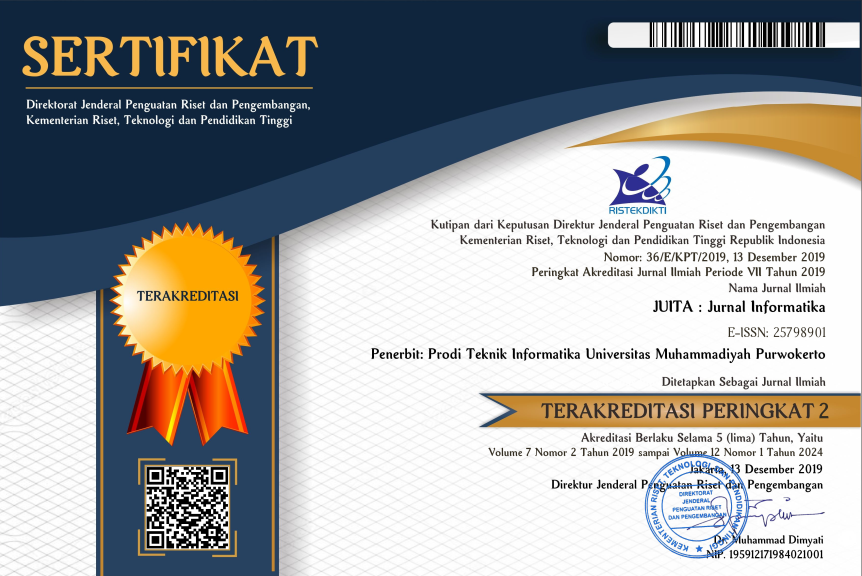Face Gender Classification using Combination of LPQ-Self PCA
Abstract
The age factor had a significant impact on human faces, potentially influencing the performance of existing gender classification systems. This research proposed a new method that combined local descriptors such as Local Binary Patterns (LBP) and Local Phase Quantization (LPQ) with Self-Principal Component Analysis (Self-PCA) as a feature extraction technique. The use of Self-PCA was chosen for its ability to address the age factor in human facial images, while also leveraging local descriptors to capture features from these images. The primary focus was to compare the performance of Self-PCA with LPQ+Self-PCA, along with the additional comparison of LBP+Self-PCA, in the task of gender classification using facial images. Euclidean distance served as the classifier, and the evaluation was conducted using the FG-Net and ORL datasets. The combination of LPQ+Self-PCA showed an improvement in accuracy by 57.85% compared to the combination of LBP+Self-PCA, which provided an accuracy of 56.47%. Meanwhile, using Self-PCA alone gave an accuracy of 55.37% on the FG-Net. In contrast, on the ORL dataset, both combinations gave the same accuracy result as Self-PCA, which was 90.14%, for images without blurring.
Keywords
References
[1] T. Ojala, M. Pietikäinen, and D. Harwood, “A comparative study of texture measures with classification based on featured distributions,” Pattern Recognition, vol. 29, no. 1, pp. 51–59, Jan. 1996, doi: 10.1016/0031-3203(95)00067-4.
[2] A. Hadid, “The Local Binary Pattern Approach and its Applications to Face Analysis,” in 2008 First Workshops on Image Processing Theory, Tools and Applications, Nov. 2008, pp. 1–9. doi: 10.1109/IPTA.2008.4743795.
[3] S. Najafi Khanbebin and V. Mehrdad, “Local improvement approach and linear discriminant analysis-based local binary pattern for face recognition,” Neural Comput & Applic, vol. 33, no. 13, pp. 7691–7707, Jul. 2021, doi: 10.1007/s00521-020-05512-3.
[4] D. Shi and H. Tang, “Face recognition algorithm based on self-adaptive blocking local binary pattern,” Multimed Tools Appl, vol. 80, no. 16, pp. 23899–23921, Jul. 2021, doi: 10.1007/s11042-021-10825-z.
[5] H. N. Vu, M. H. Nguyen, and C. Pham, “Masked face recognition with convolutional neural networks and local binary patterns,” Appl Intell, vol. 52, no. 5, pp. 5497–5512, Mar. 2022, doi: 10.1007/s10489-021-02728-1.
[6] Y. El merabet, Y. Ruichek, and A. El idrissi, “Attractive-and-repulsive center-symmetric local binary patterns for texture classification,” Engineering Applications of Artificial Intelligence, vol. 78, pp. 158–172, Feb. 2019, doi: 10.1016/j.engappai.2018.11.011.
[7] A. Hadid, J. Ylioinas, M. Bengherabi, M. Ghahramani, and A. Taleb-Ahmed, “Gender and texture classification: A comparative analysis using 13 variants of local binary patterns,” Pattern Recognition Letters, vol. 68, pp. 231–238, Dec. 2015, doi: 10.1016/j.patrec.2015.04.017.
[8] T. Song, J. Feng, S. Wang, and Y. Xie, “Spatially weighted order binary pattern for color texture classification,” Expert Systems with Applications, vol. 147, p. 113167, Jun. 2020, doi: 10.1016/j.eswa.2019.113167.
[9] C. Shan, “Learning local binary patterns for gender classification on real-world face images,” Pattern Recognition Letters, vol. 33, no. 4, pp. 431–437, Mar. 2012, doi: 10.1016/j.patrec.2011.05.016.
[10] V. Ojansivu and J. Heikkilä, “Blur Insensitive Texture Classification Using Local Phase Quantization,” in Image and Signal Processing, A. Elmoataz, O. Lezoray, F. Nouboud, and D. Mammass, Eds., in Lecture Notes in Computer Science. Berlin, Heidelberg: Springer, 2008, pp. 236–243. doi: 10.1007/978-3-540-69905-7_27.
[11] J. Kannala and E. Rahtu, “BSIF: Binarized statistical image features,” in Proceedings of the 21st International Conference on Pattern Recognition (ICPR2012), Nov. 2012, pp. 1363–1366. Accessed: Oct. 21, 2023. [Online]. Available: https://ieeexplore.ieee.org/document/6460393
[12] J. S. Nayak and M. Indiramma, “An approach to enhance age invariant face recognition performance based on gender classification,” Journal of King Saud University - Computer and Information Sciences, vol. 34, no. 8, Part A, pp. 5183–5191, Sep. 2022, doi: 10.1016/j.jksuci.2021.01.005.
[13] J. S. Nayak, M. Indiramma, and N. Nagarathna, “Modeling self-Principal Component Analysis for age invariant face recognition,” in 2012 IEEE International Conference on Computational Intelligence and Computing Research, Dec. 2012, pp. 1–5. doi: 10.1109/ICCIC.2012.6510277.
[14] A. Lanitis, C. J. Taylor, and T. F. Cootes, “Toward automatic simulation of aging effects on face images,” IEEE Transactions on Pattern Analysis and Machine Intelligence, vol. 24, no. 4, pp. 442–455, Apr. 2002, doi: 10.1109/34.993553.
[15] F. S. Samaria and A. C. Harter, “Parameterisation of a stochastic model for human face identification,” in Proceedings of 1994 IEEE Workshop on Applications of Computer Vision, Dec. 1994, pp. 138–142. doi: 10.1109/ACV.1994.341300.
[16] Ş. Öztürk and B. Akdemir, “Effects of Histopathological Image Pre-processing on Convolutional Neural Networks,” Procedia Computer Science, vol. 132, pp. 396–403, Jan. 2018, doi: 10.1016/j.procs.2018.05.166.
[17] C. Fan, M. Chen, X. Wang, J. Wang, and B. Huang, “A Review on Data Preprocessing Techniques Toward Efficient and Reliable Knowledge Discovery From Building Operational Data,” Frontiers in Energy Research, vol. 9, 2021, Accessed: Oct. 05, 2023. [Online]. Available: https://www.frontiersin.org/articles/10.3389/fenrg.2021.652801
DOI: 10.30595/juita.v12i1.21137
Refbacks
- There are currently no refbacks.

This work is licensed under a Creative Commons Attribution 4.0 International License.
ISSN: 2579-8901
- Visitor Stats
View JUITA Stats










